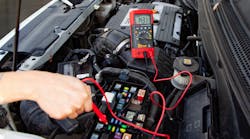- The time for diagnostics and repair in the mechanical and electrical worlds are flipped. A mechanical diagnosis is fast, but the repair can take hours; an electrical diagnosis can take hours, while the eventual repair is usually quick – sometimes only minutes. It’s important for the shop supervisor and the tech to understand this so that the process can be managed properly.
- There’s no such thing as an electrical “repair.” Once the actual fault is discovered, the electrical process ends, and the mechanical begins. Even if the fault is a shorted or broken wire, the repair is fully mechanical. When the diagnostic tools are put down and the repair tools are picked up, the process is mechanical. The only “electrical” process is the diagnosis.
- Nearly all electrical faults are simple, and 80 percent of all faults occur within the circuit. Often, a vehicle can be shut down and disabled by a fault that is entirely invisible to the naked eye. Small amounts of corrosion in any circuit can cause total failure. Oxidation only 0.001” thick on a single pin of one connector will fully destroy system operation, and in the wrong system, this fault will cause a 400-ton truck to stop dead in its tracks.
- Voltage drop is an effective diagnostic measurement. Voltage drop requires the circuit to be functioning, or complete, but if done properly, the test cannot fail. OEMs frequently specify a resistance or ohm reading, but these tests can be time-consuming, complicated, and inconclusive.
- The ohmmeter is prone to failure. The standard ohmmeter function in a digital multimeter is only designed to work within a small region of a very small system. Larger vehicles have extensive wiring harnesses, and the small amount of voltage used by an ohmmeter might not have enough energy to complete a definitive test.
- Many electrical tools are not fully effective for many circumstances. A test light is an age-old tool that most technicians either have seen or still have – even though there are more effective options. If the tool has electronic, solid state components, test lights are likely to miss a blatant fault because they aren’t sensitive enough. An older incandescent bulb tool can also damage sensitive electronic systems on vehicles.
- Schematics are often hard to acquire, and more often read incorrectly. A schematic is an illustration of circuits, and circuits comprise systems. When reading a schematic, it must beread for understanding then redrawn as a straight line. Additionally, it should be read from negative (-) to positive (+).
- All circuits are the same. Every circuit contains four essential parts – a voltage supply (+), a ground return path (-), a SINGLE load component, and switches. Even if this isn’t plainly illustrated by the OEM in the schematic, this is what is there, and this is what the tech should look for when reading. If you know this one principle, you understand every circuit.
- All “advanced” electrical systems are based upon, and work according to, old and well-understood concepts. No “modern” electrical system is truly new – electrical sensors, electrical vehicles, and all computers work according to basic principles. This suggests that all training should begin with the core components of electrical theory, and advanced training should always include these principles. “Ohm’s Law” governs nearly all circuits and systems in a vehicle. Ignoring these lessons doesn’t speed up training and diagnostics – it slows it down.
Information provided by Electronic Specialties






